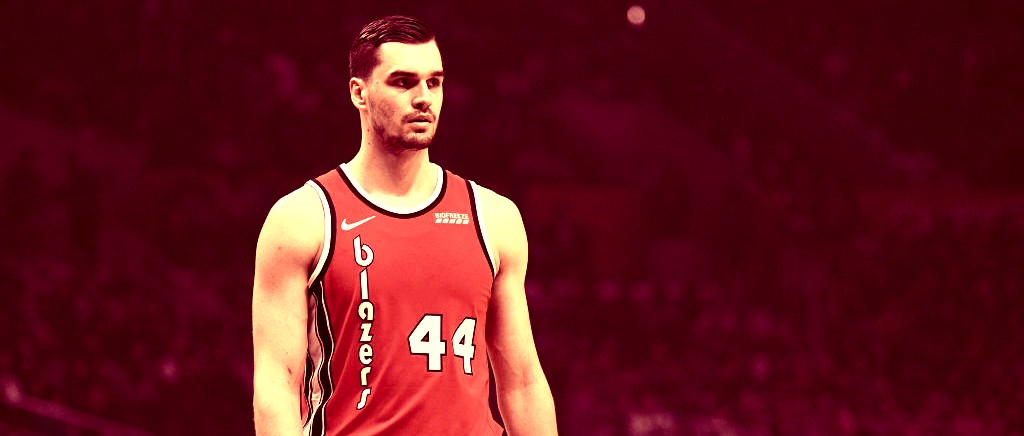A quick look at the Portland Trail Blazers roster reveals a rather significant void. A Moe Harkless-sized void, or an Al-Farouq Aminu-shaped one, whichever one you prefer.
Entering the season, the Trail Blazers employed two players whose best position could reasonably be classified as “forward”: Mario Hezonja and Anthony Tolliver. Neither of them projected to be opening night starters, as Portland embarked upon a bold endeavor to get more shooting in the lineup at the expense of traditional positions. Kent Bazemore or Rodney Hood, both of whom are better suited to defend guards, and Zach Collins, a center masquerading as a power forward, would slot into the starting lineup.
Eleven games later, that experiment’s worst-case scenario has come to fruition, and it wasn’t that hard to see coming. While that might not have been the case had Collins not suffered a shoulder injury in the third game of the season that will sideline him through March, it doesn’t change the fact that Portland planned on playing meaningful minutes this year with Hood, Hezonja, Bazemore, and Tolliver at the 3 and 4. Bazemore ranks in the 15th percentile of points per shot attempt, according to Cleaning the Glass, and his offensive output actually gleams in comparison to Hezonja and Tolliver, who rank in the second and first percentiles, respectively, in the same category.
Think about that for a second. Two players whose job is almost exclusively hitting jumpers created by Damian Lillard and C.J. McCollum are producing points worse than just about every other forward in the NBA. It’s no wonder that the Blazers have the lowest assist percentage in the league, as their role players cannot hit shots. Making matters worse is that Bazemore, Hezonja, and Tolliver have to score; they’re generally minus defenders who aren’t comfortable taking on playmaking duties. If the purpose of losing Aminu and Harkless was to open up space for Lillard and McCollum, that effort appears to have been in vain.
Hood, to his credit, has been efficient on offense. As a starter, he does benefit from playing 64 percent of his minutes with both Lillard and McCollum and 92 percent of his minutes with at least one of the two perimeter stars. Hood still is not a passer, and he has the highest turnover percentage of his career despite his lowest usage rate.
With that forward rotation, it’s a minor miracle that Portland still has the 13th best offense in the league. Part of the solution for Terry Stotts has been to revise his staggering policy. Last year, with the benefit of a deeper roster, the Blazers played 18 percent of their non-garbage time possessions without both Lillard and McCollum on the floor. This season, that percentage has been cut in half. Despite the team’s overwhelming faith in him, Anfernee Simons isn’t quite ready to take the lead on offense, even against second units. The Blazers have a minus-13.6 differential in the Simons solo minutes, which somehow undersells how much those lineups struggle.
Portland sits at 4-7 with a negative point differential, and as Tom Ziller of SB Nation pointed out on Wednesday, is wasting MVP-caliber performances by Lillard. After his first Western Conference Finals appearance, Lillard has been back with a vengeance, averaging 32.5 points per game on sterling shooting percentages, and it seems the Blazers will need all of that Herculean effort to stay in the playoff race.
Lillard deserves better. And it’s hard not to look back at the offseason and wonder why Portland allowed itself to get stuck in this situation.
The Blazers let Aminu go for nothing this summer. Their power forward for the last four years was a worthy defensive stopper who could have been retained, but instead left to sign in power forward purgatory in Orlando. They let go of their other starting forward, Harkless, in a trade for Hassan Whiteside. The theory behind getting Whiteside at least makes a little sense — he was a productive defensive center in Miami who could hopefully improve his offensive game playing on a team with better spacing, more scoring threats, and Lillard as a pick-and-roll partner.
The problem with that line of thinking is that centers are fungible, and the Blazers should have been more aware of this than just about any team. They won two playoff rounds with a backup center in Enes Kanter who was available on the buyout market and could have easily picked up another center for a similar payday. Consider how Portland might look right now had they taken a minimum flier on, say, Willie Cauley-Stein, retained Meyers Leonard, and kept Harkless. Cauley-Stein, Leonard, and Skal Labissiere could have held the fort for Portland while Jusuf Nurkic recovers from injury, and the spacing wouldn’t have been any worse than it currently is with Tolliver.
There’s a popular theory that Portland will simply flip Whiteside at the trade deadline as matching salary for an available power forward, with names like Danilo Gallinari and Kevin Love being on the receiving end of speculation. The Knicks or Magic may also have some forwards to move. At this point, though, it’s an open question if the Blazers will still be in the hunt in February.
It’s best not to write off a Lillard-led team this early in the season, and Lillard may very well have enough juice to lead a one-man playoff push. But Portland’s early season has not inspired much confidence, and perhaps more significantly, the writing was on the wall before the year even started.







